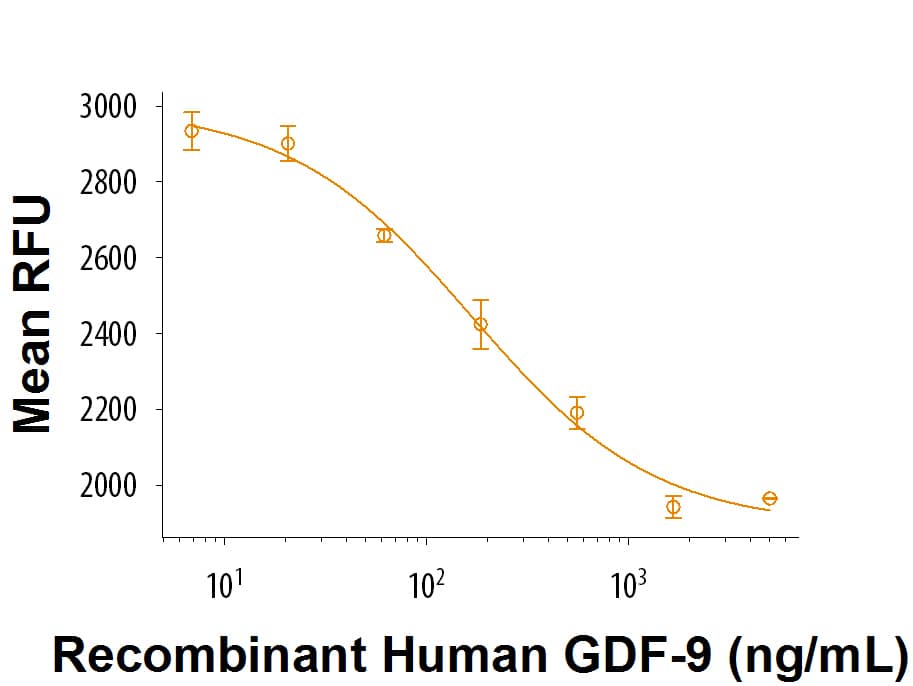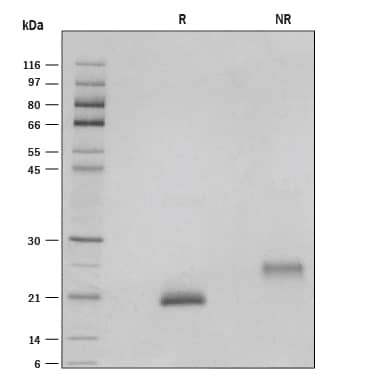Recombinant Human GDF-9 Protein Summary
Product Specifications
Gly320-Arg454 (Gly391Arg)
Analysis
Product Datasheets
Carrier Free
CF stands for Carrier Free (CF). We typically add Bovine Serum Albumin (BSA) as a carrier protein to our recombinant proteins. Adding a carrier protein enhances protein stability, increases shelf-life, and allows the recombinant protein to be stored at a more dilute concentration. The carrier free version does not contain BSA.
In general, we advise purchasing the recombinant protein with BSA for use in cell or tissue culture, or as an ELISA standard. In contrast, the carrier free protein is recommended for applications, in which the presence of BSA could interfere.
8266-G9
| Formulation | Lyophilized from a 0.2 μm filtered solution in HCl with BSA as a carrier protein. |
| Reconstitution | Reconstitute at 100 μg/mL in strerile 4 mM HCl. |
| Shipping | The product is shipped at ambient temperature. Upon receipt, store it immediately at the temperature recommended below. |
| Stability & Storage: | Use a manual defrost freezer and avoid repeated freeze-thaw cycles.
|
8266-G9/CF
| Formulation | Lyophilized from a 0.2 μm filtered solution in HCl. |
| Reconstitution | Reconstitute at 100 μg/mL in sterile 4 mM HCl. |
| Shipping | The product is shipped with polar packs. Upon receipt, store it immediately at the temperature recommended below. |
| Stability & Storage: | Use a manual defrost freezer and avoid repeated freeze-thaw cycles.
|
Scientific Data
 View Larger
View Larger
Recombinant Human GDF-9 (Catalog # 8266-G9) induces Mv1Lu mink lung epithelial cell death. The ED50 for this effect is 50-250 ng/mL.
 View Larger
View Larger
1 μg/lane of Recombinant Human GDF-9 was resolved with SDS-PAGE under reducing (R) and non-reducing (NR) conditions and visualized by silver staining, showing single bands at 20 kDa and 26 kDa, respectively.
Reconstitution Calculator
Background: GDF-9
Growth Differentiation Factor-9 (GDF-9) is an oocyte secreted paracrine factor in the TGF-beta superfamily (1, 2). It is synthesized as a prepropeptide and is subsequently processed by proteases into the mature protein (1, 2). Mature human GDF-9 has a predicted molecular weight of 16 kDa and shares 89.6% and 91.9% amino acid sequence identity with the mouse and rat orthologs, respectively. Despite the high homology, mouse GDF-9 is secreted in an active form, while human GDF-9 is latent. A single mutation Gly391Arg increases the affinity between human GDF-9 and its signaling receptors and make it more active (3). It forms both non-covalent homodimers and heterodimers with BMP-15, which is coordinately expressed with GDF-9 in the oocyte. (2, 4, 5). GDF-9 signals through TGF-beta RI/ALK-5 and BMPR-II, while the GDF-9:BMP-15 heterodimer is believed to signal through BMPR-II, ALK 4/5/7, and BMPR-IB/ALK-6 (5-8). SMAD2 and SMAD3 are phosphorylated following activation of receptor complexes by GDF-9 (5, 6). GDF-9 functions as a paracrine factor in the development of primary follicles in the ovary. It is critical for the growth of granulosa and theca cells and for the differentiation and maturation of the oocyte (5, 9-11). GDF-9 is thought to act synergistically with BMP-15 to control development of the oocyte-cumulus cell complex (4-6). In humans, GDF-9:BMP-15 heterodimers have been shown to be more potent regulators of granulosa cell functions compared to GDF-9 homodimers (6). Aberrant GDF-9 expression and activation is associated with a multitude of common human ovarian disorders including premature ovarian failure and polycystic ovary syndrome (10, 12-14). In breast and bladder cancers, GDF-9 is believed to function as a tumor suppressor because its expression levels are inversely correlated with the aggressiveness of the cancer (15, 16). In prostate cancer, however, GDF-9 may enhance tumor progression by promoting tumor cell growth and epithelial-to-mesenchymal transition (17, 18).
- McGrath, S. A. et al. (1995) Mol. Endocrinol. 9:131.
- Aaltonen, J. et al. (1999) J. Clin. Endocrinol. Metab. 84:2744.
- Simpson, C.M. et al. (2012) 153:1301.
- Liao, W.X. et al. (2003) J. Biol. Chem. 278:3713.
- Gilchrist, R.B. et al. (2008) Hum. Reprod. Update 14:159.
- Peng, J. et al. (2013) Proc. Natl. Acad. Sci. USA 110:E776.
- Vitt, U.A. et al. (2002) Biol. Reprod. 67:473.
- Mazerbourg, S. et al. (2004) Mol. Endocrinol. 18:653.
- Hreinsson, J.G. et al. (2002) J. Clin. Endocrinol. Metab. 87:316.
- Otsuka, F. et al. (2011) Mol. Reprod. Dev. 78:9.
- Dong, J. et al. (1996) Nature 383:531.
- Zhao, S.Y. et al. (2010) Fertil. Steril. 94:261.
- Wei, L.N. et al. (2011) Fertil. Steril. 96:464.
- Simpson, C.M. et al. (2014) J. Clin. Endocrinol. Metab. [Epub ahead of print].
- Hanavadi, S. et al. (2007) Ann. Surg. Oncol. 14:2159.
- Du, P. et al. (2012) Int. J. Mol. Med. 29:428.
- Bokobza, S.M. et al. (2010) J. Cell. Physiol. 225:529.
- Bokobza, S.M. et al. (2011) Mol. Cell. Biochem. 349:33.
Citations for Recombinant Human GDF-9 Protein
R&D Systems personnel manually curate a database that contains references using R&D Systems products. The data collected includes not only links to publications in PubMed, but also provides information about sample types, species, and experimental conditions.
3
Citations: Showing 1 - 3
Filter your results:
Filter by:
-
New insights into the genetic basis of premature ovarian insufficiency: Novel causative variants and candidate genes revealed by genomic sequencing
Authors: S Jaillard, K Bell, L Akloul, K Walton, K McElreavy, WA Stocker, M Beaumont, C Harrisson, T Jääskeläin, JJ Palvimo, G Robevska, E Launay, AP Satié, N Listyasari, C Bendavid, R Sreenivasa, S Duros, J van den Be, C Henry, M Domin-Bern, L Cornevin, N Dejucq-Rai, MA Belaud-Rot, S Odent, KL Ayers, C Ravel, EJ Tucker, AH Sinclair
Maturitas, 2020-06-20;141(0):9-19.
Species: Human
Sample Types: Reference Standard
-
Growth differentiation factor 9 promotes follicle-stimulating hormone-induced progesterone production in chicken follicular granulosa cells
Authors: J Li, W Luo, T Huang, Y Gong
Gen. Comp. Endocrinol., 2019-03-06;0(0):.
Species: Chicken
Sample Types: Whole Cells
Applications: Bioassay -
In vitro differentiation of human embryonic stem cells into ovarian follicle-like cells
Authors: D Jung, J Xiong, M Ye, X Qin, L Li, S Cheng, M Luo, J Peng, J Dong, F Tang, W Shen, MM Matzuk, K Kee
Nat Commun, 2017-06-12;8(0):15680.
Species: Human
Sample Types: Whole Cells
Applications: Bioassay
FAQs
No product specific FAQs exist for this product, however you may
View all Proteins and Enzyme FAQsReviews for Recombinant Human GDF-9 Protein
There are currently no reviews for this product. Be the first to review Recombinant Human GDF-9 Protein and earn rewards!
Have you used Recombinant Human GDF-9 Protein?
Submit a review and receive an Amazon gift card.
$25/€18/£15/$25CAN/¥75 Yuan/¥1250 Yen for a review with an image
$10/€7/£6/$10 CAD/¥70 Yuan/¥1110 Yen for a review without an image
